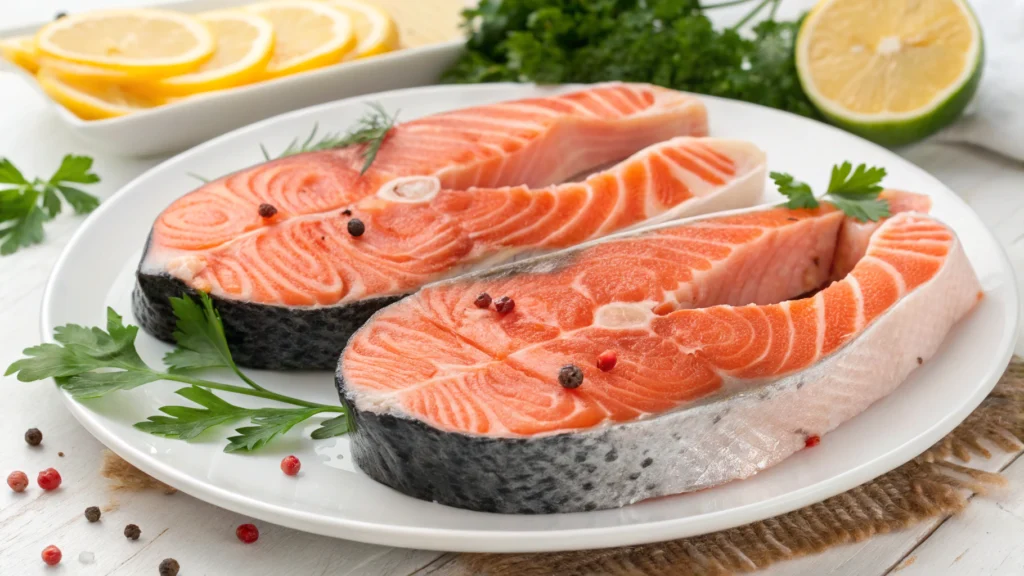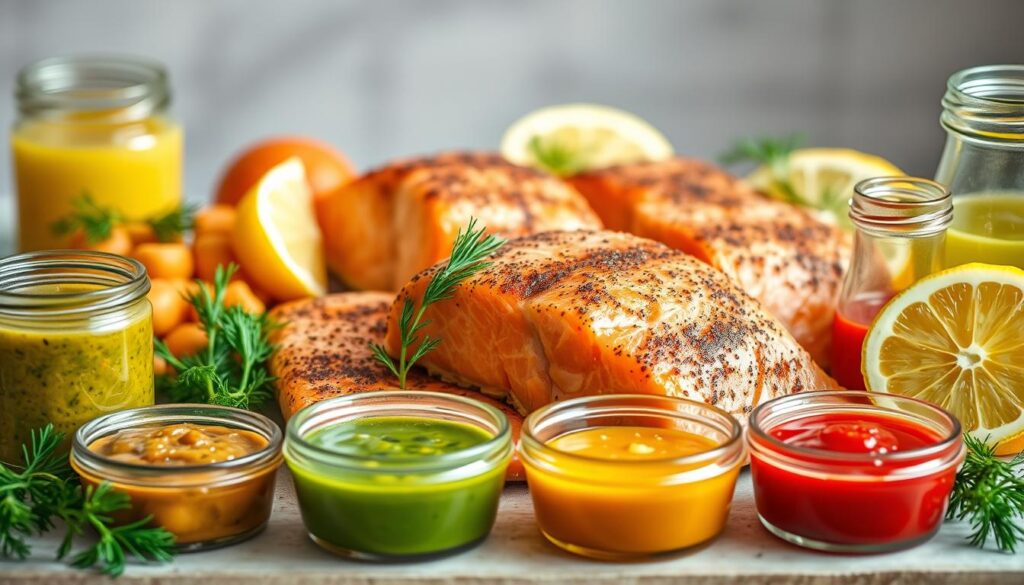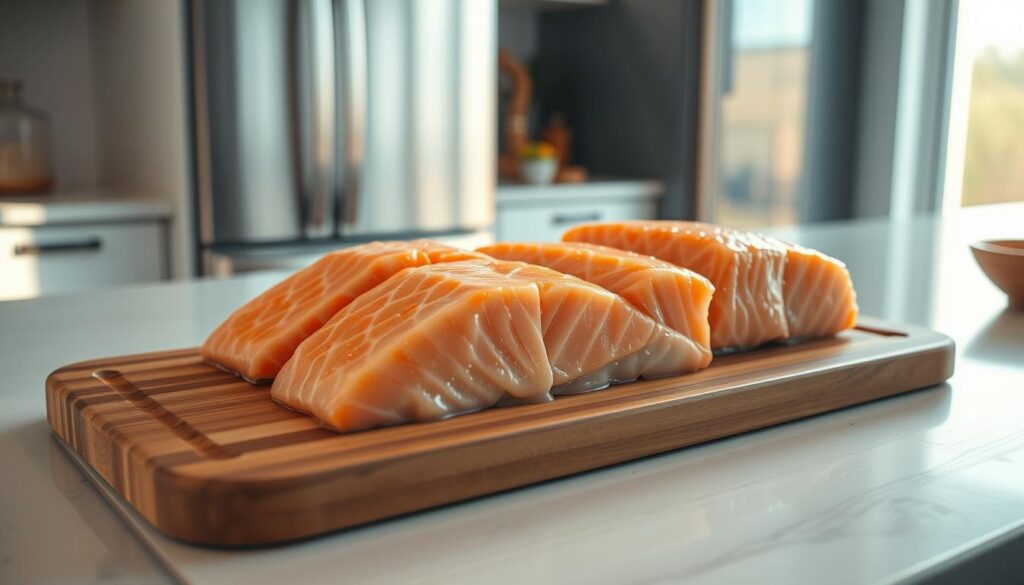
Every home cook dreams of serving a restaurant-quality salmon fish steak. It’s a dish that makes taste buds dance with delight. I remember the first time I mastered cooking salmon perfectly. The golden-brown crust and tender, flaky interior were amazing.
Salmon fish steaks are more than just a meal; they’re a culinary adventure. Whether you’re a seasoned chef or a cooking novice, this guide will change how you prepare these delectable fish cuts.
Cooking the perfect salmon fish steak isn’t about complicated techniques. It’s about understanding the basics and cooking with confidence. You’ll soon become an expert at creating mouthwatering salmon dishes that impress every time.
Understanding Salmon Fish Steaks vs Fillets
Exploring wild-caught Pacific salmon can be exciting. Knowing the difference between steaks and fillets can make your cooking better. Each cut has its own taste, cooking style, and enjoyment level.
What Makes Steaks Different from Fillets
Salmon steaks are cut across the fish, including the backbone. Fillets, on the other hand, are long, boneless cuts from the side. The main differences are:
- Bone content: Steaks have more bones
- Texture: Steaks are denser and firmer
- Cooking method: Steaks are best for grilling or pan-searing
Benefits of Choosing Salmon Steaks
Choosing wild-caught Pacific salmon steaks has many benefits:
- Enhanced flavor profile from bones and skin
- Keeps moisture better during cooking
- Looks more appealing on the plate
“The secret to great salmon is selecting the right cut and understanding its unique characteristics.” – Professional Chef
How to Select Quality Cuts
When picking wild-caught Pacific salmon steaks, look for these signs of quality:
- Bright, vibrant color
- Firm, smooth texture
- Fresh, ocean-like smell
- Minimal browning or discoloration
The best salmon steaks should look moist and have a rich color. Choosing well can greatly improve your cooking.
Essential Ingredients for Perfect Salmon Fish Steak
Starting with the right ingredients is key to making tasty seafood recipes. For a salmon steak, you need top-notch parts that make the salmon’s natural flavor pop. This is especially true for sustainably caught salmon.
Here’s what you should have:
- Extra virgin olive oil – for healthy cooking and rich flavor
- Unsalted butter – adds depth and promotes beautiful browning
- Fresh garlic – provides aromatic intensity
- Fresh lemon juice – brings brightness and acidity
- Honey – creates a subtle sweetness
- Crushed red pepper flakes – adds a hint of heat
Using olive oil and butter together is a game-changer. It lets you cook at high temperatures. This way, your salmon steak gets a beautiful golden crust.
“The secret to perfect seafood is using fresh, high-quality ingredients and understanding how they interact.” – Professional Chef
Choose your salmon from sustainable sources. Look for Marine Stewardship Council certifications or seafood watch program recommendations. This ensures your meal supports eco-friendly fishing.
Preparing Your Salmon Before Cooking
Getting your salmon ready is key to a tasty dish. It’s not just about cooking. It’s about how you handle and prepare the fish.
Salmon needs careful attention to taste and nutrition. By using expert techniques, you can make a simple fish into a memorable meal.
Proper Thawing Techniques
Thawing salmon right is important. It keeps the fish fresh and safe. Here are the best ways to thaw:
- Refrigerator thawing: Place frozen salmon in the fridge 24 hours before cooking
- Cold water method: Submerge sealed salmon in cold water, changing water every 30 minutes
- Avoid thawing at room temperature to avoid contamination
Seasoning Methods
Seasoning is where nutrition meets flavor. Try these tips to boost taste:
- Pat salmon steaks dry with paper towels
- Season both sides with salt and black pepper
- Try herbs like dill, parsley, or thyme for extra flavor
Temperature Considerations
Temperature is crucial for cooking salmon right. Letting it come to room temperature helps it cook evenly.
| Temperature Stage | Recommended Action | Expected Result |
|---|---|---|
| Refrigerator Storage | Keep at 40°F or below | Preserve freshness |
| Pre-Cooking | Rest at room temperature 15-20 minutes | Even cooking, better texture |
| Cooking | Medium-high heat | Crisp exterior, moist interior |
Pro tip: Always use a meat thermometer to ensure your salmon reaches a safe internal temperature of 145°F for optimal salmon nutrition and food safety.
Pan-Searing Techniques for Perfect Results
Learning to pan-sear grilled salmon is all about precision and managing heat. The right method can turn a simple fish into a dish that’s both crispy and tender.
To get amazing grilled salmon, follow these key steps:
- Choose a heavy-bottomed cast iron skillet for even heat distribution
- Pat salmon steaks dry with paper towels to ensure proper searing
- Select high-heat cooking oils like avocado or refined olive oil
Temperature control is the secret to perfect grilled salmon. Heat your skillet to medium-high, around 375-400°F. This heat will create a golden-brown crust without burning the fish.
“Patience is key when pan-searing salmon. Let the fish cook undisturbed to develop a beautiful crust.” – Professional Chef Recommendation
Cooking times depend on the thickness of the salmon steak:
- 1-inch thick steaks: 3-4 minutes per side
- 1.5-inch thick steaks: 4-5 minutes per side
- Aim for an internal temperature of 145°F
Season your salmon with salt and pepper before cooking. A light dusting of herbs can also boost the flavor of your grilled salmon. This makes for a wonderful dining experience.
Alternative Cooking Methods
Trying new cooking ways can make your baked salmon amazing. Each method adds special flavors and textures. This gives you many options for tasty salmon steaks.
Cooking salmon isn’t just about pan-searing. Both chefs and home cooks enjoy the variety of techniques. These methods can make your seafood prep better.
Grilling Your Salmon Steaks
Grilling salmon steaks adds a smoky taste that many love. To avoid sticking and get perfect grill marks:
- Preheat grill to medium-high heat
- Clean and oil grill grates well
- Cook salmon for 4-5 minutes on each side
- Use a fish spatula for easy flipping
Baking Salmon to Perfection
Baked salmon is a quick and easy dinner for weeknights. Seasoned with herbs like sage and cooked in butter, it can taste like a restaurant dish in just 15 minutes.
- Preheat oven to 400°F
- Place salmon on a lined baking sheet
- Season with salt, pepper, and herbs
- Bake for 12-15 minutes until fish flakes easily
Broiling for a Crispy Exterior
Broiling is a quick way to get a crispy outside while keeping the inside moist. Place your oven rack 4-6 inches from the broiler and cook for 5-7 minutes.
Pro tip: Watch your salmon closely to prevent overcooking, as broilers can quickly burn the fish.
Creating Flavorful Sauce Combinations

Take your salmon steaks to the next level by mastering delicious sauce combinations. Seafood recipes come alive when you balance the fish’s natural flavors. This way, you avoid overpowering them.
Your sauce choice can turn a simple salmon steak into a fancy meal. Think about these classic flavors that pair well with salmon:
- Lemon-Herb Butter Sauce: Bright citrus with fresh herbs
- Honey-Garlic Glaze: Sweet and savory mix
- Dill-Mustard Cream: Tangy and rich
When making seafood recipes, remember to keep things balanced. A good sauce should boost, not hide, the salmon’s taste. Use top-notch ingredients like fresh herbs, real butter, and quality seasonings.
Pro tip: Always prepare your sauce ingredients before cooking the salmon. This ensures perfect timing and temperature.
Quick sauce-making tricks can make your seafood recipes taste like they’re from a restaurant. In just minutes, you can make a sauce that makes your salmon steak unforgettable.
- Melt butter with minced garlic
- Add fresh chopped herbs
- Season with salt and black pepper
- Spoon over salmon during final cooking moments
Try out different sauces and find your own special seafood recipe sauce. It will wow your family and friends.
Testing for Doneness and Proper Temperature
Cooking salmon right is all about paying attention to doneness and temperature. Getting it just right means you get the most out of its nutrition and taste. Plus, it keeps your food safe to eat.
Figuring out when your salmon is done can be a bit tricky. Experts say using more than one way to check is best.
Visual Indicators of Perfectly Cooked Salmon
The look of your salmon can tell you a lot. Here are the signs to watch for:
- Color changes from translucent pink to opaque
- Flaky texture that separates easily
- Uniform color throughout the fish
- Glossy, moist surface without dry edges
Internal Temperature Guidelines
An instant-read thermometer is your go-to for tracking salmon nutrition. The perfect internal temperature is 145°F. This is at the thickest part of the steak.
Resting Time Recommendations
After cooking, let your salmon rest for 3-5 minutes. This step is key for:
- Juice redistribution
- Temperature equalization
- Enhanced flavor development
- Continued gentle cooking
“Perfect salmon is about precision and patience” – Professional Chef
Pro tip: Your salmon will keep cooking a bit after you take it off the heat. So, take it out just before it hits the final temperature you want.
Storage and Leftover Management

Keeping your salmon steaks fresh is key for quality and eco-friendly fishing. You can turn leftover salmon into tasty dishes with the right storage methods.
Refrigeration is the top choice for storing cooked salmon. Place your steaks in an airtight container for up to three days. It’s important to keep moisture in to preserve the fish’s taste and texture.
Refrigeration Guidelines
- Use shallow, airtight containers
- Cool salmon completely before storing
- Store at or below 40°F
- Consume within 3 days
Freezing Techniques
Freezing is great for longer storage that’s good for the planet. Wrap your salmon steaks in freezer-safe packaging to avoid freezer burn.
| Storage Method | Maximum Storage Time | Recommended Technique |
|---|---|---|
| Refrigeration | 3 days | Airtight container |
| Freezing | 3 months | Vacuum-sealed bag |
Reheating Tips
When reheating salmon, use gentle methods to keep it moist. Low and slow reheating is best for flavor and moisture.
- Preheat oven to 275°F
- Place salmon in a covered dish
- Heat for 10-15 minutes
- Check internal temperature reaches 145°F
By using these storage and reheating tips, you’ll cut down on food waste. Your leftover salmon can be tomorrow’s tasty meal.
Conclusion
Preparing salmon steaks is an art that combines nutrition and flavor. Wild-caught salmon is packed with omega-3 fatty acids, boosting your health. It also makes your meals taste like they’re from a restaurant.
Learning to cook salmon steaks lets you make healthy and tasty meals. You can pan-sear, grill, or bake it, each way bringing out different flavors. The secret is to keep the fish’s natural taste and texture.
Choosing the right salmon is key to a great dish. Go for wild-caught for better taste and more omega-3s. With time, you’ll get better at cooking it just right, making it a gourmet treat.
Try out different marinades, cooking methods, and sauces. Each try will make you better at cooking salmon steaks. It’s a fun way to add variety to your meals. Start your journey to becoming a salmon cooking pro today.
FAQ
What are the health benefits of eating salmon steaks?
How do I know if I’m buying a quality salmon steak?
What’s the best way to cook salmon steaks to preserve their nutritional value?
Can I freeze salmon steaks?
What are some quick seasoning ideas for salmon steaks?
How can I tell when my salmon steak is perfectly cooked?
What’s the difference between salmon steaks and salmon fillets?
Are salmon steaks sustainable?
How Our Recipe Turned Out in Your Kitchens?
My family loved it.
I tried this recipe last weekend, and it turned out perfect! The instructions were super clear, and my family loved it. Definitely adding this to our regular meal rotation!

2 thoughts on “How to Cook Perfect Salmon Fish Steaks Every Time”
Comments are closed.